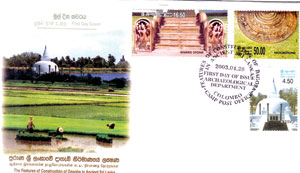Over centuries, Buddhist shrines have been very much part and parcel of our
culture and heritage.
The artistic creations
related to these shrines bear testimony to a great
civilisation that existed since the introduction
of Buddhism in the
3rd Century BC. They are not mere places of Buddhist worship but marvels of
construction.
A set of three stamps released in April 2008,
featured salient features of a dagoba.
Also known as a stupa
or 'chaitya', the dagoba
(Rs. 4.50 stamp) is a
dome-like structure topped like a pinnacle built to enshrine relics of the Buddha or of Saints.
A prominent feature of Buddhist architecture, the dagoba is a part of every temple. It is generally built at a higher elevation of the temple premises.
Made of brick and lime, it is always coated with white paint giving it a serene
appearance and a look of purity.
There are at least six types of dagobas, each being distinguished by its shape.
They are:
- Bell - shaped (Ghantakaara)
- Pot-shaped (Ghatakaara)
- Bubble-shaped (Bubbulakaara)
- Paddy heap-shaped (Dhaanyakaara)
- Lotus-shaped (Padmakaara)
- Fruit-shaped (Amalaakaara)
The last two mentioned are not seen in Sri Lanka.
The first stupa in
Sri Lanka – the
Thuparama was erected in Anuradhapura, the royal city by King Devanampiya Tissa (250 – 210 BC) enshrining the
collar-bone of the Buddha. One of the smaller stupas built in Sri Lanka, it was originally in the shape of a heap of paddy.
The Guard-stones or 'muragal' (Rs. 16.50 stamp) are a common feature at the entrance to stupas, image houses, Bodhi trees and other places of worship. They are sculptured slabs of stone with rounded tops placed at the ends of the balustrades flanking the flight of steps.
Many of them contain
representations of Naga kings both in animal and human form. The one
represented in the stamp is the human form dressed in royal attire. It has a
full vase on one hand
– a 'purna ghata' or
'pun kalasa' – a symbol of
prosperity and a flowering branch on the other.
The latter is a symbol of
fertility.
The Naga king
usually stands in a
graceful attitude bent
leftwards at the waist and with the weight of the head supported by the left foot, the other being placed slightly forward, bent at the knee. With one foot it is shown trampling a dwarf, which symbolises evil
influences. Thus the Naga king is supposed to
prevent evil influences entering the building and to bestow prosperity on its inmates.
The Moonstone – 'sandakada pahana'
(Rs. 50 stamp) is a
semi-circular slab of stone at the foot of a flight of steps to a stupa or shrine room. It is a masterpiece demonstrating the skills of the ancient Sinhala
sculptor.
The one which appears in the stamp is found at the Queen's Pavilion in Anuradhapura and is one of the three most beautiful moonstones found in the first royal city.
The design of the
moonstone had developed from a plain slab of stone to one with a lotus flower at the centre into a more
elaborate one, which according to the renowned archaeologist Professor Senarat Paranavitana has a deep meaning related to the teachings of the Buddha.
The outermost
decoration show
conventional flames,
followed by a row of four beasts – the elephant, horse, lion and the bull appearing in a procession chasing each other.
A creeper with a wavy stem and intricate foliage
comprises the next band
followed by a band of swans. |


